
Infinity, Inc. is a team of superheroes appearing in American comic books published by DC Comics.
The Injustice Society is a group of supervillains in the DC Comics Universe. They are the main antagonists of the Justice Society of America.

Jade is a superhero in the DC Comics Universe. She first appeared in All-Star Squadron #25 in September 1983. She is the daughter of Alan Scott and Rose Canton and twin sister of Obsidian.
Wildcat is the name of several fictional characters, all DC Comics superheroes, the first and most famous being Theodore "Ted" Grant, a long-time member of the Justice Society of America (JSA). A world-class heavyweight boxer, Grant became entangled inadvertently in the criminal underworld and developed a costumed identity to clear his name.

Courtney Elizabeth Whitmore, known as Stargirl and formerly as the second Star-Spangled Kid, is a superhero created by Geoff Johns and Lee Moder who appears in American comic books published by DC Comics. The character's name, appearance, and personality were patterned after Johns' 18-year-old sister Courtney, who died in the explosion of TWA Flight 800 in 1996.

Johnny Thunder is the name of three superheroes appearing in comics published by DC Comics. A fourth character has the variant name Jonni Thunder.

Jakeem Thunder, initially called J.J. Thunder, is a fictional character in the DC Comics Universe, a member of the superhero team the Justice Society of America.

Wildcat is a fictional superheroine in DC Comics' shared universe, the DC universe. She first appeared in Infinity, Inc. #12, and was created by Roy Thomas, Dann Thomas, and Don Newton.

Ultra-Humanite is a supervillain appearing in American comic books published by DC Comics. He first appeared as a recurring adversary of Superman, and was among the first villains faced by him. He was designed to be the polar opposite of Superman; while Superman is a hero with superhuman strength, Ultra-Humanite is a criminal mastermind who has a crippled body but a highly advanced intellect. The Ultra-Humanite served as Superman's nemesis until Alexei Luthor and his Silver Age counterpart Lex Luthor were introduced in the comics. The origins of the super-criminal known as the Ultra-Humanite are shrouded in mystery. Even he claims not to remember his true name or appearance and attributes his vast intellect and mental prowess to scientific experiments of an unknown nature.
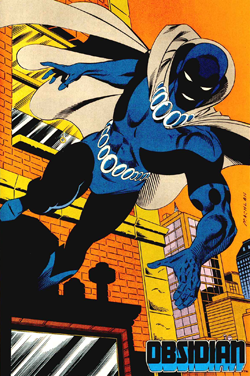
Obsidian is a superhero published by DC Comics. He first appeared in All-Star Squadron #25, and was created by Roy Thomas and Jerry Ordway. He is the son of Alan Scott and Rose Canton and the twin brother of Jade. According to an Infinity, Inc. letter page, Obsidian was named "Todd" after a friend of Thomas.
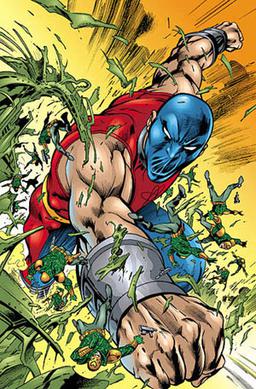
Albert Julian Rothstein is a superhero appearing in American comic books published by DC Comics. Atom Smasher is known for his power of growth and super strength.

Eclipso is a supervillain in American comic books published by DC Comics. Created by Bob Haney and Lee Elias, the character would first appear in House of Secrets #61. The character bears notable similarities to Dr. Jekyll and Mr. Hyde.

Northwind is a fictional character appearing in American comic books published by DC Comics.

The Sportsmaster is the name of different supervillains appearing in American comic books published by DC Comics. The first version of the character; Lawrence "Crusher" Crock, is usually depicted as a criminal who uses sports-themed weapons and gadgets to commit crimes. He is also the husband of Paula Brooks and the father of Artemis Crock.

Icicle is the name of two supervillains appearing in comic books published by DC Comics: Joar Mahkent and Cameron Mahkent.
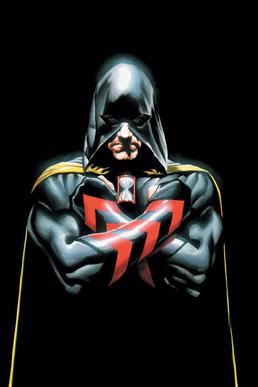
Hourman is a fictional superhero who was created by Roy Thomas, Dann Thomas and first appeared in Infinity Inc. #20 as Rick Tyler, son of the original Hourman, who quickly joined Infinity Inc. as the second Hourman in #21 of that book.
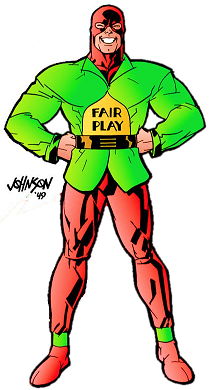
Terry Sloane is a fictional superhero appearing in DC Comics, and the first character named Mister Terrific. He first appeared in Sensation Comics #1.
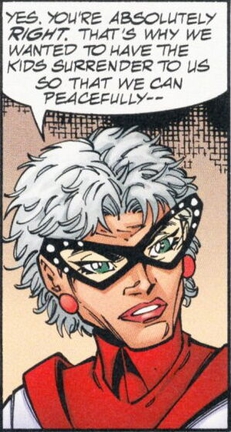
Merry Pemberton, also known as Gimmick Girl and Merry, Girl of 1000 Gimmicks is a fictional character in the DC Comics Universe. She is the adoptive sister of Sylvester Pemberton. Merry Pemberton first appeared in Star-Spangled Comics #81 in June 1948, and ran through #90. She was created by writer Otto Binder.
Brain Wave is a supervillain appearing in the DC Comics Universe. He is a recurring foe of the Justice Society of America, a founding member of the Injustice Society, and the father of the superhero Brainwave.
















